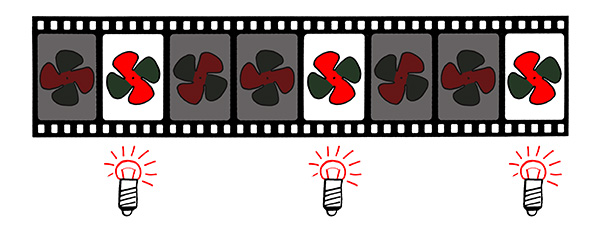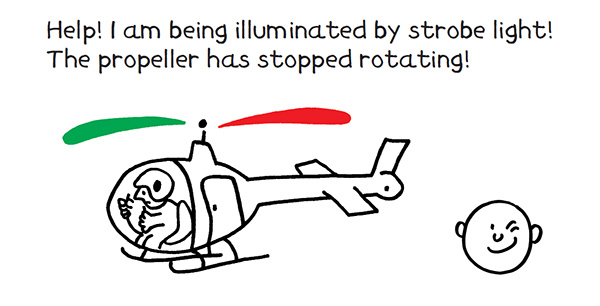Do and observe!
Click one of the buttons below the video. The pinwheel starts to turn, and eventually the red pinwheel blades seem to stop.
The frequency of the reed and green flashes can be regulated by clicking the red and green buttons. Clicking the button with a minus decreases the frequency of the flashes, while clicking the button with the plus increases it.
Vary the frequency of the flashes and observe the patterns on the pinwheel. Observe the color of the pinwheel at the point where the red and green blades seem to overlap.

What's going on?
During the short flash of red or green light our eyes see the pinwheel at a certain position. If the flashes are bright enough and follow each other rapidly you will not notice the dark intervals of the rotation of the pinwheel. At a certain frequency of the flashes the pinwheel makes one complete turn between consecutive flashes, and the pinwheel seems to come to a standstill.
The pair of red blades is more visible in red light, and the green blades are more visible in green light. Each pair of blades can thus be separately "controlled" by properly adjusting the frequency of the red and green flashes.
More...
Set the flashes to such a rate that the blades of one color, say red, appear to be standing still. When you then slightly reduce the frequency of the flashes of red light, the pinwheel turns a little more than a full revolution between consecutive flashes, and it appears to be turning slowly in one direction.
If you slightly increase the frequency, the pinwheel turns a little less than a full revolution and will appear to be turning in the opposite direction. Through careful adjustment of the rates of both the red and green lights you will get a state where one pair of blades will seem to stand still, while the other will rotate, or they will rotate at different rates and even in opposite directions.

When you set the frequency of the green and red flashes to such a rate that the two pairs of blades rotate as slowly as possible in opposite directions, you will notice yellow color in the areas where the blade pairs overlap. In fact you are only experiencing the sensation of yellow color. The sensation is created in your brain when the sensory cells in the brain are stimulated simultaneously by red and green light.
Did you know?
Computer screens are constructed out of light elements - pixels. Each pixel consists of three smaller red, green and blue parts. The elements are so small that the light emitted by neighboring elements gets merged in the sensory cells of our eyes.
In the places on the screen where only red and green elements are emitting light we therefore see yellow color.

 e-Science Centre
e-Science Centre


